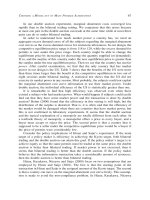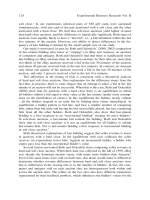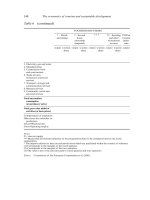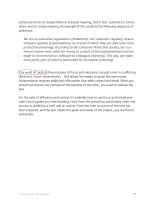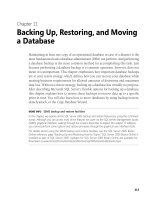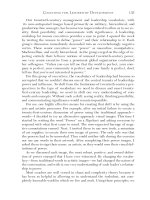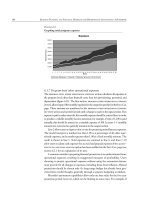ESSENTIALS of Business Process Outsourcing 2005 phần 6 ppsx
Bạn đang xem bản rút gọn của tài liệu. Xem và tải ngay bản đầy đủ của tài liệu tại đây (139.96 KB, 24 trang )
General RFP Guidelines
There are several general guidelines for developing an effective RFP. One
of the most important is to be clear about the business process slated for
outsourcing and the scope of work required from the vendor.At the same
time, RFPs should not be so long and burdensome that some qualified ven-
dors will elect not to respond. Several items that should be included are:
•
Administrative. This section includes information about the
BPO buyer’s company, business priorities, purpose of the RFP,
deadlines for response, required format, assessment criteria, and
contact information.
•
General requirements. This section details expectations regarding
the services to be provided, reporting and information sharing,
customer service, claims resolution, contract implementation,
training, and benchmarks for fees. For example, a firm that is
seeking to outsource its help desk function might have a sec-
tion including details about the function (Exhibit 4.3).
•
Pricing requirements. This section outlines the expected pricing
approach, including goals for net rates and volume discounts.
•
Contractual/legal. This section provides details about expected
contract terms and conditions, warranties, remedies, and any
disclaimers.
Generally speaking, the VST should be able to eliminate two or three
from the list after reviewing the bids, because some vendors’ skills will
not match the project needs.A letter should be sent out immediately to
the eliminated vendors.This will leave five to eight remaining for further
evaluation.
Step 6: Evaluate the Proposals
Initial screening of the proposals may reveal interesting facts about the
vendor. For example, the VST should scan each one to determine if it
addresses the organization’s unique needs. Often, a BPO vendor will use
108
ESSENTIALS of Business Process Outsourcing
4377_P-04.qxd 1/31/05 12:34 PM Page 108
a generic template or cut and paste material from another proposal and
simply insert it in the current one. This often indicates the vendor has
not focused specifically on what the buyer needs. A good BPO vendor
must be customer oriented, and the proposal should be directly written
for the buyer’s project.
Second Telephone Interview
Remaining vendors should be scheduled for telephone interviews of
about one hour in length. During this teleconference, the vendor should
explain its proposal in detail, including addressing issues such as:
•
Approach
•
Company background
•
Experience in the process area
•
Strengths
•
Availability
109
Vendor Selection and Contracting
BPO Qualifications Weighting System
Parameter Weight
Quality:
•
ISO Certification .20
•
Six Sigma
Performance History:
•
Experience with other, similar projects .25
•
Performance with other clients
Warranties and Claims Policies .10
Facilities and Capacity .15
Geographic Location .05
Technical Capability .25
EXHIBIT 4.3
4377_P-04.qxd 1/31/05 12:34 PM Page 109
•
Certifications
•
Suggested solution
The VST should then request a submission of tender and set a firm
deadline for its receipt.The tender is a precise document that spells out
exactly what the vendor intends to do and how it intends to establish
fees and the invoice schedule. The vendor should also be requested to
furnish:
•
Case studies. These should reflect projects similar to the BPO
buyer’s project.
•
Copies of resumes. Each vendor will probably send resumes of
its best personnel.The buyer should ensure that these individu-
als will actually work on the project.
•
Copies of certifications. BPO vendors often cite industry certifi-
cations, such as ISO or Six Sigma. Buyers should request copies
of these certificates to verify their authenticity.
•
References. Buyers should request at least three positive refer-
ences and, when possible, one negative reference. It is impor-
tant that the BPO buyer talk with at least one of the vendor’s
customers that experienced a negative result.This will help
determine how the vendor handled the project when it
was failing and why contingency plans did not correct the
problems.
•
Proof of financial stability. It is not unusual to request that ven-
dors provide documentation showing their financial stability,
number of employees, how long they have been in business,
and the maturity of their facilities.
Step 7: Select a Short List
The VST should now have enough information to select the three to five
most qualified vendors, who should be contacted and invited in for face-
to-face formal presentations.
110
ESSENTIALS of Business Process Outsourcing
4377_P-04.qxd 1/31/05 12:34 PM Page 110
Vendor Presentation
The VST should meet with one vendor per day.The vendor visits should
be limited to four hours and be scheduled as close together as possible so
the VST can compare notes on each vendor while impressions are still
fresh.The VST should set the meeting agenda and share it with each ven-
dor in advance. At the beginning of the formal presentation, the VST
chairperson should:
•
Inform the vendor that it has made the short list.
•
Explain that the vendor has four hours for its presentation.
•
Express interest regarding the vendor’s pricing model.
•
Reiterate what the organization is looking for in a BPO vendor.
•
Let the vendor know there will be a final telephone conference
to clarify the bid submitted.
•
Ask the vendor to submit its best bid no later than the deadline
you have established.
•
Let the vendor know when the decision will be made.
During the presentation,VST members should look for the following:
•
Who has the vendor sent to the meeting?
•
Is the presentation developed uniquely or canned?
•
Does the vendor include contingency plans?
•
What performance data does the vendor provide?
•
Who are the vendor’s leading clients?
•
How well does the vendor team listen to the buyer team?
•
Does the vendor’s presentation address issues in the RFP?
Special attention should also be paid to the logical architecture out-
lined in the presentation. Many vendors demonstrate their technology
expertise, but lack deep understanding of workflows and process
improvement opportunities (the logical architecture). Failure to address
111
Vendor Selection and Contracting
4377_P-04.qxd 1/31/05 12:34 PM Page 111
the logical architecture of the business process being outsourced is one
of the most obvious signs that a vendor lacks maturity in that process.
Final Review
After the presentations are over, the final review begins.The VST should
review all presentation material in great detail, along with the notes
recorded by those who attended the presentations. Someone within the
VST should record all questions the team may have, as these can be
answered in the final phone conferences with each vendor.This confer-
ence call is to clarify outstanding issues about the proposal and to discuss
the formal presentation. During the call, the BPO buyer should com-
municate the following:
•
Explain to the vendor that it is among the finalists.
•
Explain that this will be the final presentation.
•
State that final pricing schedules must be articulated.
The vendor should be allowed to ask questions. The buyer should
state that a decision will be made and a vendor selected within a defined
period (usually two weeks).This helps motivate the vendor into making
the best deal possible to win the buyer’s business.
After the conference, the buyer should select two or three vendors
for a second face-to-face presentation. Once this selection has been
made and the vendors have been informed, the meetings should be
scheduled as soon as possible. Each vendor should be informed it has
four hours for the final presentation.
Step 8: Select the Vendor
Final vendor selection should be completed shortly after the second
round of face-to-face presentations. By this time, it is usually clear which
vendor’s proposal best meets the long- and short-term needs of the
buyer. However, the VST may decide that none of the vendors is suitable.
If that occurs, it is in the interest of the organization to abandon the
112
ESSENTIALS of Business Process Outsourcing
4377_P-04.qxd 1/31/05 12:34 PM Page 112
BPO project. For many executives and managers, this may be difficult
given the investment of personal time and other resources. But sound
business decision making sometimes requires firms to cut their losses and
move on rather than gerrymandering the specifications or allowing the
vendor to alter its bid to try to force a fit.
Precontract Stage
If a vendor is selected, there are still several steps to consider before mov-
ing to the contract stage:
•
Members of the BPO buyer’s staff who are scheduled for trans-
fer to the vendor should meet the new management team before
contracts are signed.
113
Vendor Selection and Contracting
Make Time for Adjustments
A useful exercise is to ensure the contract will stand up to the rig-
ors and complexities of the actual operation. A trial period is ideal
for making adjustments before the contract becomes final and for
judging the likelihood of the partnership’s breaking down. In gen-
eral, this period should not be less than 90 days—long enough to
allow anything unexpected to arise.
For example, when Lehman Brothers decided to outsource its IT
function to an offshore firm, it spent more than $8 million on 80 sep-
arate pilot projects with the various finalists.
a
Remember, the BPO
buyer and vendor are attempting to develop a partnership, and there
are going to be problems that must be worked through.
After the test period, the main issue that needs to be addressed is
the unexpected work that has surfaced and how it will affect the ven-
dor’s cost proposal. At the same time, the buyer should be cautious
about judging the service levels, because new people and processes
will improve performance levels over time.
a
Mario Apicella, “Shaking Hands Is Not Enough,” InfoWorld (April 30, 2001): 49–50.
T
IPS
&T
ECHNIQUES
4377_P-04.qxd 1/31/05 12:34 PM Page 113
•
Employees should be allowed to air concerns and ask questions.
This can help reduce any feelings that they are being cast aside.
•
The firms should address issues of terms and conditions of
employment, including appropriate compensation if vendor
employment is not available or not required.
•
If additional training will be necessary as a result of joining the
new organization, it should be brought to light.
•
Leaders of the BPO implementation from both parties should
discuss the objectives of the new work processes, reinforce
what the organizations want to achieve, and understand how
members of the interorganizational work teams will contribute
to the team’s success.
BPO Contract
First-time outsourcing projects fail to meet their objectives for reasons
that are as varied and complex as outsourcing relationships themselves.
And while failures are generally not strictly legal in nature, a poorly
drafted contract is one of the most significant reasons cited for unsuc-
cessful relationships.The careful negotiation and drafting of a good out-
sourcing contract can not only preserve the potential of an outsourcing
project, but also minimize the risk of failure and eliminate most other
points of dissatisfaction.
114
ESSENTIALS of Business Process Outsourcing
Rules of Thumb for Effective
BPO Contracting
David S. Piper, attorney, Boyer & Ketchand, LLP, Houston, Texas,
offers these guidelines for BPO contracting:
“First, everyone involved in the process should keep in mind the
nature of the BPO relationship. The alignment of the long-term strate-
I
NTHE
R
EAL
W
ORLD
4377_P-04.qxd 1/31/05 12:34 PM Page 114
115
Vendor Selection and Contracting
gic interests of both the BPO buyer and vendor should be reflected
in the terms of the contract.
“Second, it is important to be able to describe services and perfor-
mance levels in precise language. The contract should include
details about measuring service performance and steps to take to
remedy performance shortfalls.
“Finally, it is important for the parties to plan for exit. This element
of BPO contracts is often overlooked because it suggests that, at
some point in the future, the relationship will end. However, handling
exit provisions is a good way to make sure that when the relationship
does end, it ends amicably.
“When it comes to common mistakes that companies make in devel-
oping an outsourcing contract, one is the failure to test performance
metrics and measurement strategies. One firm that I recall out-
sourced its help desk process. Part of the agreement was that the
quality of service would be measured using a help desk customer sur-
vey. The help desk vendor applied the quality survey to every single
help desk inquiry, which greatly annoyed the BPO buyer’s employees.
“To make matters worse, completion of the survey was required to
close out the trouble ticket. As a result, help desk staff frequently
called employees to implore them to answer the survey questions so
they could close out the ticket. Overlooking the impact of the survey
on the attitudes of employees led to a lot of criticism and needless
griping in this case.
“A way to help keep legal costs to a minimum in BPO contract devel-
opment—and this may sound paradoxical—is to get the legal team
involved early. Early involvement ensures that the team is well versed
in the business process and understands appropriate service levels
metrics. Firms should also get the legal team involved with the oper-
ational staff so they don’t end up writing the contract in the abstract.
The more familiar the team is with the actual business process, the
better it will be able to draft effective service level standards.”
Source: David Piper, Boyer & Ketchand, Attorneys at Law, Houston, Texas.
4377_P-04.qxd 1/31/05 12:34 PM Page 115
Negotiating BPO Contracts
Although this discussion is intentionally brief and not designed to sup-
plant the many excellent books written on the art of negotiation, it is
important to examine the nature of negotiating BPO contracts.
The complexity and evolving nature of the outsourcing process
demands a different mindset than is required in traditional commercial
contract negotiation (Exhibit 4.4).
5
It is not a zero-sum game, in which
each party is motivated to extract as much value as possible from the lim-
ited available resources, even to the detriment of the other party.
6
In
these types of negotiations, the outcome is win–lose in that one party or
the other gets its way. Although there may be clear advantages for the
winner, the relationship is likely to become adversarial rather than col-
laborative.This probably will not promote the kind of long-term collab-
oration critical to successful BPO initiatives.
116
ESSENTIALS of Business Process Outsourcing
EXHIBIT 4.4
Negotiations
with
Vendor/Supplier
Negotiations
with
BPO Provider
Zero sum
Adversarial
Win-Lose
Short-term
Fixed terms
Positive sum
Collaborative
Win-Win
Long-term
Flexible terms
Standard Vendor Negotiations versus
BPO Negotiations
4377_P-04.qxd 1/31/05 12:34 PM Page 116
However, developing an effective BPO contract requires a positive-
sum approach whereby the parties are interested in creating more value
than currently exists. It aims for the proverbial “win–win” outcome and
seeks long-term, flexible contract terms. This requires compromise by
both parties.At the same time, risks associated with compromise can be
mitigated through creative incentive clauses and remedies in the event of
nonperformance. Such contract innovations are part of the terms of a
BPO contract.
A First Look
From the BPO buyer’s perspective, selecting an outsourcing provider and
negotiating the contract is also the first opportunity to evaluate the ven-
dor’s culture and mindset, and to determine if the fit is a good one. Buy-
ers can use several strategies to determine the character of the firm they
have selected. For example, different negotiating strategies may be
employed to distinguish a cooperative vendor from an adversarial one.At
the outset of the selection process, buyers may attach a proposed form of
the master outsourcing contract (without detailed exhibits such as scope
of work, service-level agreements, and pricing) to the RFP in order to
evaluate which vendors will accept the general terms and conditions.
Vendors unwilling or reluctant to accept these terms and conditions
without significant negotiation can be readily identified and disqualified.
Terms of the Contract
Although BPO contract negotiations should be conducted in a positive-
sum spirit, it would be naive to assume that trust is a sufficient govern-
ing mechanism. In fact, drafting precise contract terms, including avenues
for remedy in case performance falls short of expectations, can help pre-
serve a relationship during difficult stretches.The discussion that follows
outlines terms that should be considered and included in the formal
BPO contract. Although not an exhaustive set, the terms discussed are
117
Vendor Selection and Contracting
4377_P-04.qxd 1/31/05 12:34 PM Page 117
part of nearly every BPO contract and constitute the core of the work-
ing relationship.They include:
•
Scope of work (SOW)
•
Service-level agreements (SLAs)
•
Pricing
•
Term of the contract
•
Governance
•
Intellectual property
•
Industry-specific concerns
•
Termination of the contract
•
Transition
•
Force majeure
•
Dispute resolution
Scope of Work
The linchpin of the contract is a description of the nature of the work
being outsourced, often referred to as the scope of work or statement of work.
The BPO buyer’s attorneys must work closely with the buying organiza-
tion’s personnel to become intimately familiar with the details of the out-
sourced processes in order to prepare a clear, complete statement of work.
Provisions of a well-drafted contract should outline the change process
as it pertains to the SOW, whether such change is incremental because of
technological developments or organic because of acquisitions or divesti-
tures by the client.They should also delineate the processes by which the
work will be transitioned from buyer to vendor. Personnel, hard assets, and
soft assets (intellectual property, vendor contracts, license agreements, etc.)
all may be transferred to the vendor. Particular care must be taken in the
personnel area as well. Employees with key institutional knowledge or
other unique capabilities should be considered for retention.Well-qualified
project managers must be retained to staff the buyer’s governance team.
118
ESSENTIALS of Business Process Outsourcing
4377_P-04.qxd 1/31/05 12:34 PM Page 118
Awareness of Employment Laws Is Critical
Attention must also be paid to the employment laws that regulate the
BPO vendor, especially when there is an international component to the
project. In the European Union (EU), for example, in certain cases when
a business unit is transferred, the new employer must offer transferred
employees the same wages and benefits the employees have with their
current employer. Staffing needs should be carefully considered, because
layoffs and reductions in force are often more complicated in foreign
jurisdictions. The EU has also enacted stiff laws that protect workers
from loss of income if their employer should decide to outsource their
jobs. The Applied Rights Directive is designed to protect employees’
jobs, pay, and conditions when organizations sell or outsource parts of
their business operations to other companies or contracting firms.
The United Kingdom has enacted similar legislation known as Trans-
fer of Undertakings Protection of Employment (TUPE). These regula-
tions are potent protectors of employment rights and can make it difficult
for European firms to realize dramatic cost benefits from outsourcing.
Service-Level Agreements
In an SLA, a vendor agrees to achieve defined levels of performance
(Exhibit 4.5). If the vendor fails to meet these objectives, the SLA pro-
vides the buyer with various rights and remedies.A carefully crafted set
of SLAs aligns the interests of the vendor and buyer.
7
Poorly drafted
SLAs almost ensure a failed relationship.
8
Unfortunately, SLAs are among the most difficult of outsourcing
contract provisions. A solid SLA requires an intimate understanding of
business processes by the attorneys drafting the agreement (SLAs should
not be drafted by nonlawyers).The parties must document in great detail
the requirements of each outsourced process and agree on how to mea-
sure service levels and consequences for the failure to meet them.
9
119
Vendor Selection and Contracting
4377_P-04.qxd 1/31/05 12:34 PM Page 119
120
ESSENTIALS of Business Process Outsourcing
Sample Text for Service Level Agreements
Scope and Definition
Outsource contractor shall “own” continuation engineering for mature
products, as agreed upon by the company and the outsource contractor.
This will enable outsource contractor to design the product for a high
volume assembly environment and with component parts sourced to
take advantage of outsource contractor purchasing leverage. This is
expected to drive significant cost reductions in future products.
Outsourcing Contractor Responsibilities
•
Release bill of material for new SKU number.
•
Assume responsibility for initiating, executing and implementing
engineering change orders in support of ongoing product
enhancements.
•
Perform cross-functional cost reduction and product improvement
activities.
•
Provide technical assistance to Company in effecting resolutions to
product quality problems.
•
Provide a cost reduction plan to Company. The plan should include
feasibility report, design study, and analysis of specifications.
•
Support product “end of life” activities to minimize scrap and
obsolescence.
•
Review and approve component-level first article inspection.
Company Responsibilities
•
Develop, maintain, and provide customer requirement specification.
•
Approve key technology and engineering changes initiated by
outsource contractor.
•
Provide all specifications, artwork, and packaging of the products.
•
Provide firmware support for outsource contractor-initiated and
Company-approved engineering changes.
EXHIBIT 4.5
4377_P-04.qxd 1/31/05 12:34 PM Page 120
Defining What to Measure The foundation of the SLA is defining
which service levels and key performance indicators (KPIs) to measure.
An SLA may be tied to anything that can be objectively quantified but
is usually a measure of such indicators as quality, speed, availability, relia-
bility, capacity, timeliness, or customer satisfaction.With a call center, for
example, service levels might include the average time to answer a call,
the duration of the call, the percentage of issues satisfactorily resolved in
the first call, and customer satisfaction.
Service levels must be intimately tied to pricing in order to properly
align the financial interests of the vendor and the business goals of the
buyer. For example, pricing tied to the number of problems fixed may
create a disincentive to stop the problems from happening in the first
place. Quality is generally a better service-level measure than quantity,
especially in fixed-price scenarios.
Precise Terms,Variables, and Responsibility Once appropriate ser-
vice levels are agreed on, terms must be used with precision. For example,
what does it mean for a computer system to be “available”? If the buyer can
access the system, but it performs sluggishly, is that system available? What
if the system is unavailable to the buyer because of something beyond the
vendor’s control? Who bears the risk of a failed service level in that instance?
Drilling down to issues such as these in the negotiation process will avoid
needless disputes during the performance stage of the BPO initiative.
Service levels may vary depending on hours of operation or other
variables. Response times should account for these factors, including dif-
ferences in time zones.Agreement must be reached between the parties
regarding how to measure service levels.Technologic capabilities may be
a constraining factor, particularly with smaller buyers and vendors. Softer
measurements, such as customer satisfaction, may meet with resistance,
both from the vendor and from the buyer’s personnel who are now
required to fill out satisfaction surveys as a result of the outsourcing
121
Vendor Selection and Contracting
4377_P-04.qxd 1/31/05 12:34 PM Page 121
process. If possible, the buyer should implement service-level measure-
ments before outsourcing, both to obtain a baseline and to determine the
adequacy of the measurement process.
The SLA should also address who is responsible for measuring ser-
vice levels and how often. Depending on the type of activity being mea-
sured, service levels can be measured by the vendor, the buyer, third
parties, or some combination. The time period for which the service
level is measured should be long enough to be meaningful, but not so
long as to be cost prohibitive or unfair to the vendor. Of significance is
the fact that pricing, in the form of credits or bonuses, may be tied to
achieving or failing to achieve service levels, as well as events of default.
Credits can be handled through either cash rebates to the buyer or cred-
its against future amounts owed to the vendor. Reporting and availabil-
ity of compliance data should be agreed upon.
122
ESSENTIALS of Business Process Outsourcing
Avoiding a Common Mistake
in Setting Service Levels
Organizations often set a standard or average service level but neglect
to define appropriate levels for out-of-compliance performance.
For example, if the service level for a call center requires that 95 per-
cent of all calls must be answered within a certain time period, the
SLA should also address the minimum acceptable standard for the
remaining 5 percent of the calls.
SLAs should set target service levels and minimum service levels. Devi-
ations from target service levels can result in credits to the buyer or
bonuses to the vendor, as appropriate. Failure to meet minimum service
levels may result in termination of the outsourcing contract for cause.
Careful consideration should also be given to the buyer’s remedies
resulting from failure to meet service levels. Credits and contract ter-
mination may be appropriate responses.
T
IPS
&T
ECHNIQUES
4377_P-04.qxd 1/31/05 12:34 PM Page 122
Planning for Changes in Service Levels The buyer and vendor
need to anticipate that service levels will change over time, whether
because of changes in customer requirements, technologic advances, reg-
ulatory requirements, or improvements in the vendor’s processes. Because
of the specificity required in SLAs, vendors and buyers should fully dis-
cuss the change processes that will be agreed on. Both parties need to
keep in mind that the touchstone for SLAs and change processes should
be to align the interests of the vendor and buyer as much as possible.
Pricing
Pricing of outsourced services may be set in any number of ways, and
combinations of the various pricing alternatives are common. Fixed fee,
volume of transactions, and cost plus are some common examples of
options used in BPO relationships. In evaluating the pricing of an out-
sourcing agreement, BPO buyers should be aware that certain costs relat-
ing to the management of the outsourcing relationship can never be
eliminated.
The choice of fee structure for a BPO contract should be motivated
primarily by the desired outcomes. Buyers and vendors must consider
the fee structure of the contract because unexpected future events could
lead to financially burdensome obligations. For example, a BPO contract
may specify that the vendor receive compensation for every successful
handling of a returned retail item.This may be workable if the retailer
controls its returns and has trained its customers to return goods only if
they have the receipt. However, the fee structure would become
unworkable if the retailer unilaterally decided to waive the receipt
requirement, leaving the vendor overwhelmed with returned goods it
has no way of verifying.
Outsourcing arrangements can run from thousands to millions of
dollars over the course of a multiyear agreement, depending on the size
and complexity of the work. In general, contracts can be written on a
123
Vendor Selection and Contracting
4377_P-04.qxd 1/31/05 12:34 PM Page 123
fixed price or variable pricing basis. However, those are just two of the
available contract pricing options (Exhibit 4.6).
124
ESSENTIALS of Business Process Outsourcing
BPO Pricing Models
Cost Plus
This model entails the service provider to be paid the actual costs, plus
a predetermined profit percentage. This model allows very little flexibility
when business objectives and technology change during the duration of
the outsourcing contract. Neither does it provide any incentive for the
service provider to perform more efficiently.
Unit Pricing
This model assumes a predetermined rate established by the service
provider for a particular level of service. The organization pays based on
its usage.
Fixed Pricing
In this model, a fixed price for the service is established for the duration
of the contract. Some organizations prefer this approach, as they know
exactly what the service provider’s price will be, even in the future. The
challenge with this approach is that the organization must adequately
define the scope of the process and design effective metrics before
signing the contract. If not, the impact will be the service provider
claiming a particular service or service level that is beyond the scope of
the contract, making the buyer liable for additional charges.
Variable Pricing
This pricing model involves the use of a fixed price at the low end of the
service provider’s service with variables based on higher service levels.
The effectiveness of this model depends on specifically defining the
scope of process and metrics.
EXHIBIT 4.6
4377_P-04.qxd 1/31/05 12:34 PM Page 124
125
Vendor Selection and Contracting
Performance-Based Pricing
Providing incentives to motivate the service provider to perform at peak
level is the main thrust of this model. For example, the organization
could offer a bonus reward if a project is completed ahead of schedule
or demand that the service provider pay a penalty if performance is
below the satisfactory level stipulated in the contract. Performance-
based model should be used to extract excellence in the delivery of the
service provider.
Co-Sharing Risk/Reward
In this model, the organization and the service provider each have an
amount of money at risk and each stands to gain a percentage of the
profits if the service provider’s performance is optimum and achieves
the organization’s business objectives. Outsourcing is not just about
throwing everything away to the outsourcing partner to save costs. It
can be a profitable relationship for both the outsourcing organization
and the service provider if they were to work out the service level
agreement and pricing model, as well as set the expectations from the
beginning.
Term of the Contract
The term of the contract is important, especially since many companies
terminate outsourcing arrangements before the end of the contract
period. The term should at minimum match the life cycle of the
processes involved and the changes in the business cycle. Setting the
term should take into account the volatility of the outsourced service,
including anticipated changes in scope, SLAs, and pricing. It should also
be considered in the context of the client’s right to end the contract for
convenience (without cause) and of the direct and indirect costs associ-
ated with such termination, as discussed later.
4377_P-04.qxd 1/31/05 12:34 PM Page 125
Governance
Governance is the process of administering and monitoring the perfor-
mance phase of the BPO life cycle to ensure that the interests of the ven-
dor and buyer remain aligned and that the goals of the parties are met
through the most efficient processes available. Stated more simply, it
involves assessing performance and managing change.Depending on the
size and complexity of the outsourcing relationship, governance may be
implemented through single points of contact between the parties or
through committees with multiple representatives of both parties.
Certain basic factors are fundamental to the success of the gover-
nance process. Communication and reporting are essential. The gover-
nance structure should address schedules of meetings and scope of
authority, especially with respect to change processes involving SOW,
compliance with SLA standards, and the use of benchmarking to estab-
lish new standards or pricing. Depending on the seniority of those
involved in the process, escalation of disputes arising from governance
may also be appropriate.
Intellectual Property
The transfer, use, disclosure, protection, and development of intellectual
property (IP) are some of the most significant legal issues in the out-
sourcing process.When first considering an outsourcing initiative, com-
panies should carefully assess the IP ramifications of outsourcing.
10
IP laws and enforcement vary considerably around the world. Many
countries have laws protecting IP and are signatories to the World Trade
Organization’s intellectual property rights provisions, which are collec-
tively known as the Trade-Related Aspects of Intellectual Property Rights
(TRIPs). However, there is a mixed track record of local enforcement of
IP rights belonging to U.S. firms outsourcing offshore. Until the countries
where vendors are located establish a better record of protecting these
rights, BPO buyers who rely on the laws do so at their peril.
11
126
ESSENTIALS of Business Process Outsourcing
4377_P-04.qxd 1/31/05 12:34 PM Page 126
Obviously, the most prudent course is to keep vital IP within the
United States. If an organization does transfer IP offshore, however, it
should rely heavily on self-help to protect its assets.
12
This begins with
conducting thorough due diligence regarding potential vendors and their
security and confidentiality procedures. It also includes understanding the
culture of the vendor’s country toward the IP of foreigners; it is no secret
that some nations view foreign IP as communal property.There are indi-
cations that India would like to differentiate itself from these countries by
providing strong legal protection for the IP of foreigners.
Industry-Specific Concerns
Depending on the nature of the outsourced process, additional regula-
tory hurdles may need to be addressed. For example, if the outsourced
process involves health care information such as insurance claims pro-
cessing, the contract should address compliance with the Health Insur-
ance Portability and Accountability Act of 1996 (HIPAA). HIPAA requires
that health care organizations establish procedures and systems to prevent
unauthorized access to certain protected health information.
13
Pursuant
to HIPAA, the buyer must have the right to terminate the outsourcing
contract if the vendor breaches any provision of HIPAA and fails to cor-
rect the problem. Similarly, if the client is a financial institution subject to
the Gramm-Leach-Bliley Act (GLB), and the outsourced process
involves financial information of customers, then the contract should
address compliance with GLB.
14
Under GLB, financial institutions must
secure private customer data.
Termination of the Contract
In considering termination provisions, the initial focus should be to antic-
ipate the circumstances under which BPO buyers might desire to end the
outsourcing relationship.The contractual right to terminate a BPO rela-
tionship can be granted for two reasons: (1) convenience and (2) cause.
127
Vendor Selection and Contracting
4377_P-04.qxd 1/31/05 12:34 PM Page 127
Because of the requirement for flexibility and change management
in the outsourcing process, it is imperative that the buyer has the right to
terminate for convenience. In most instances, vendors will be justified in
requiring a fee in conjunction with termination for convenience. The
amount should vary in relation to the anticipated financial position of
the parties at the time of the termination.
Typically, vendors cannot terminate for convenience because of the
extreme cost, risk, and disruption resulting to the buyer. If the vendor
insists on allowing termination for convenience, the termination fee
specified in the contract should reflect these factors. Typically, vendors
can terminate only for cause, usually meaning the failure of the buyer to
pay amounts owed to the vendor.
The contract should specifically define what allows the buyer to ter-
minate for cause.Areas to be addressed include:
•
Material as well as continuing or repetitive nonmaterial
breaches of the outsourcing contract.
•
Financial insolvency or insecurity of the service provider,
including setting objective standards for financial insecurity,
reporting requirements, and auditing rights.
•
Retention of key employees or overall turnover rates of the
vendor’s workforce.
•
So-called cross-default provisions with respect to the vendor’s
contracts with other service providers (subcontractors) that
may or may not be working on the buyer’s outsourced process.
If the service provider is in default under these contracts, it can
constitute a default under the outsourcing contract.
•
Changes in control with respect to the vendor.These may
result in the replacement of the management team in which
the buyer placed its trust at the outset of the relationship or
may result in the vendor’s providing services to—or even
becoming a competitor of—the buyer, with attendant risks to
the buyer’s IP.
128
ESSENTIALS of Business Process Outsourcing
4377_P-04.qxd 1/31/05 12:34 PM Page 128
•
Changes of control with respect to the buyer.These may result
in the divestiture of the processes being outsourced or other-
wise obviate the need for outsourcing altogether. New man-
agement of the buyer may not be comfortable with
outsourcing for any number of reasons, so the vendor should
have the right to end the contract because of management
changes.
Transition
If a BPO relationship falls apart and one or both parties decide to ter-
minate the agreement, it may be necessary for the buyer to reabsorb the
outsourced process or find another vendor. In either case, the transition
of the outsourced process should be considered in the original contract.
The reasons for this are clear. Consider all of the planning and imple-
mentation entailed in outsourcing a process from a buyer to a vendor.
Now imagine how much more difficult that process might be when the
original buyer is no longer in control of the process and its assets and
personnel. To add to the challenge, consider the fact that the transition
may well be from an unhappy or incompetent vendor.Thus, the transi-
tion from one vendor to another, or the reintegration of the outsourced
process back to the buyer, is exponentially more difficult than the orig-
inal outsourcing process. As a result, careful consideration should be
given as to how the transition may be effected, and detailed transition
provisions included in the contract.
A transition plan should have a commitment by the vendor to pro-
vide transition-planning assistance. This should include inventories of
hard and soft assets, copies of relevant data, detailed descriptions of pro-
cedures, and other information relevant to the outsourced process.The
buyer should have the right to use this data and disclose it to other
potential vendors, to purchase the assets and hire key personnel related to
the outsourced process, and to assume key contracts.
129
Vendor Selection and Contracting
4377_P-04.qxd 1/31/05 12:34 PM Page 129
Furthermore, the plan should address the need for parallel process-
ing for some period of time while the process migrates to a new vendor
or back to the buyer. There may also be a need for continued use of
shared assets, such as computer networks. And just as aligning vendor–
buyer interests is vital to a successful contract, aligning those interests
during the transition is equally significant. Usually, this takes the form of
monetary incentives for a successfully implemented transition.
Force Majeure
Outsourcing contracts typically include force majeure clauses, which
excuse the vendor from performance in the case of natural disasters such
as fire and weather-related catastrophes. In light of the geopolitical pos-
tures of many of the countries where BPO vendors are located, war and
terrorism are also likely triggers of force majeure clauses. However,
because of the significant function that outsourced processes often play
in the buyer’s business, a well-crafted contract should contemplate more
than just excusing the vendor from performance during the force
majeure event. It should also link the triggering of a force majeure event
with disaster recovery plans and business continuation plans. To the
extent that a buyer cannot significantly minimize its risk in that regard,
insurance should be addressed.
Dispute Resolution
The outsourcing contract is a living document that must have change
management processes integrated within it. Change, however, inevitably
invites disagreement, and the contract should anticipate this.The dispute
resolution process begins where corporate governance ends. When all
elements of the governance process have been engaged and the parties
have still failed to resolve their dispute, legal processes must be pursued.
These processes can have escalation procedures built in, just like the
governance process. Dispute resolution may be initiated through infor-
130
ESSENTIALS of Business Process Outsourcing
4377_P-04.qxd 1/31/05 12:34 PM Page 130
mal, nonbinding procedures such as mediation. Beyond these procedures,
however, the dispute resolution process will progress to either binding
arbitration or litigation. If the parties decide to use arbitration, they must
agree on the rules. In international transactions,parties often use the rules
and procedures promulgated by the International Chamber of Com-
merce’s International Court of Arbitration;
15
in domestic transactions,
they often specify that arbitration will be conducted pursuant to the
Commercial Arbitration Rules of the American Arbitration Association.
In either case, questions of venue and choice of law must be addressed.
Venue is the place where the dispute is to be resolved.The parties should
consider questions of efficiency in terms of proximity to the persons and
facilities proximate to the dispute as well as questions of neutrality.
Choice-of-law provisions determine what laws will govern the inter-
pretation of the contract and rules of the dispute, and they are usually
determined by the golden rule—he who has the gold rules.
Summary
Identifying, selecting, and contracting with the right BPO vendor is
essential to the success of any initiative.The selection process should be
thorough and rigorous and take on a life cycle of its own that includes
appointing a vendor selection team; establishing qualifications; develop-
ing an initial long list of potential vendors; distributing a request for
information, followed by the RFP; evaluating the proposals; culling the
list of prospective vendors; and making a final decision. In the event that
no vendor satisfies the specific requirements of the RFP, the buyer should
consider abandoning the BPO project rather than altering the specifica-
tions or forcing a fit.
Similar attention and consideration should go into developing the
BPO contract, especially given the fact that poorly crafted contracts
are a key contributor to the failure of buyer-vendor relationships.The
terms of any BPO contract are numerous and far-reaching, requiring a
131
Vendor Selection and Contracting
4377_P-04.qxd 1/31/05 12:34 PM Page 131

